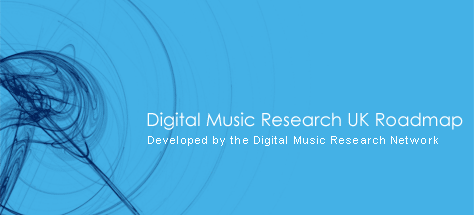- Machine
Listening
- Fertile environments for creativity
- Music Exploitation and Distribution
- Musical Innovation
- High-Level Parametric Control
- Sound Reproduction and Recording
- Fertile environments for creativity
- Music Exploitation and Distribution
- Musical Innovation
- High-Level Parametric Control
- Sound Reproduction and Recording
Research Goals in Digital Music: A Ten Year View
 Music Exploitation
and Distribution
Music Exploitation
and Distribution
Recent advances in Digital Music Research point to many new and enhanced ways
that music will be stored, distributed and used over the next 10 years. This will include:
- Pervasive access to music
- Search and access tools
- Archiving and preservation
- High-resolution multichannel musical audio
- Coding and compression
- Musical content in research
Advanced search and access tools are needed to allow users to find the music that they want. Textual labels and descriptions (metadata) are likely to remain important. Recent research in the visualization of metadata from musical collections points to new ways users can search through their own collection or remote collections of music. The goal of allowing the user to find new music they might like to hear, through methods and interfaces designed to extend the consumer's "senses" into the "space" of available music, will require research on many aspects of audio presentation and interaction.
Archiving and preservation of musical audio recordings is important to preserve recorded material for current and future generations. The National Sound Archive collects recordings issued in the UK, many donated by publishers, as well as selected overseas recordings. Efficient and effective use of such archives will need research into efficient compression and storage methods, and content analysis for metadata generation. New tools to allow visualization, searching and browsing through such archives will also be needed. Some of the requirements for these tools will be similar to tools which allow access to commercial music collections. Professional music researchers and musicologists will have special needs for search, visualization and analysis tools beyond those required for the casual music listener.
Increased media storage capacity will make high-resolution multichannel audio a practical commercial proposition in future. Such systems will require new research into recording and reproduction methods [see Musical Innovation], but will require further research into encoding and compression technology.
Efficient coding and compression of audio signals will continue to be required in the future, despite increased storage and internet bandwidths. New research towards object-based coding could provide high quality, low bit-rate musical audio coding, for example for cost-effective real-time streaming of music to mobile devices. Auditory scene analysis [see Machine Listening] could provide similar encoding methods for efficient transmission of high-resolution multichannel audio. Effective scalable audio coding systems will also be required to allow seamless transmission of musical audio content to automatically adapt to heterogeneous networks with varying capacities.
Digital rights management (DRM) is currently a major issue for music publishers, consumers and researchers, and involves complex and controversial discussions about fair and unfair use of artistic material. While current DRM systems may successfully restrict access to use by an individual person, they may also restrict use to a particular device, contrary to the expectation of many users. Interoperability is also an issue, with different music publishers and device manufacturers operating incompatible DRM systems. Research and development into DRM systems will require cooperation on a global scale, and may also need to reflect future changes in the structure and heterogeneity of the music distribution industry.
The use of musical content in research is also a difficult issue for researchers. In many research fields, experimental data is made available to aid comparison between results. This is not possible where the "data" used for experiments includes copyright musical recordings. New research methodologies are being explored to tackle this issue. These include the use of specially commissioned artistic material released under Creative Commons licences which allow free redistribution of the recorded material. For larger corpuses of existing copyright material, the submission of experimental algorithms to closed systems that perform evaluation without releasing the controlled content is already being explored. Closer links with music content rights owners may allow "research use" rights to be developed in this area.
[Top]

